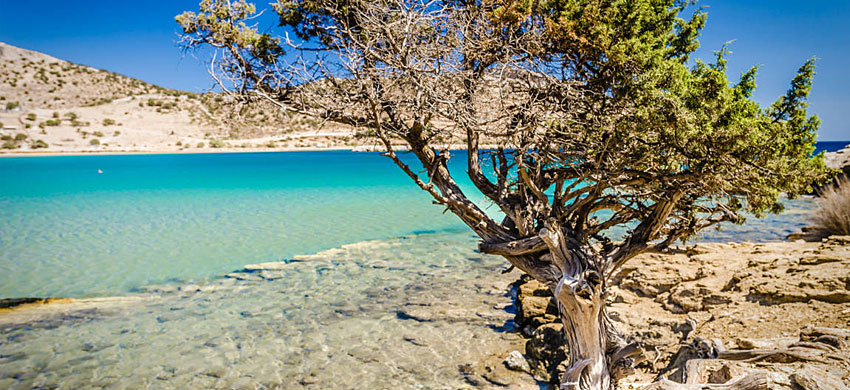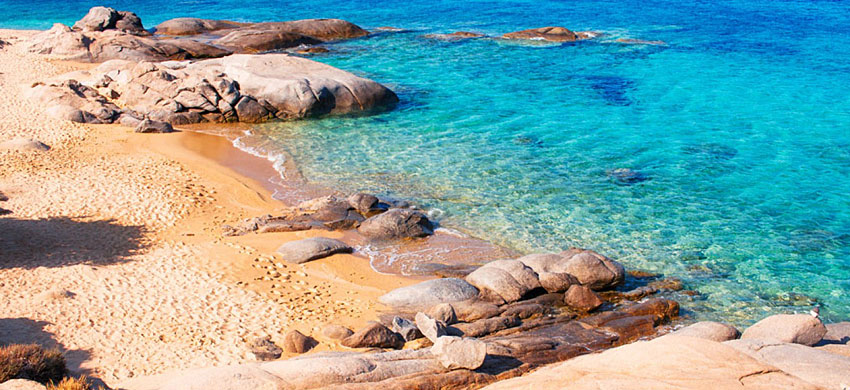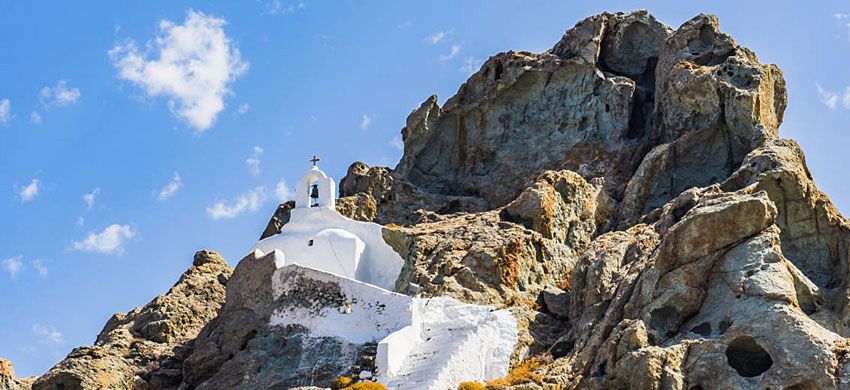

Naxos (also called Naxos), island of the myth of Ariadne, is the largest and the most fertile of the Cyclades. Among famous tourist resorts, isolated beaches, characteristic villages, historical sites and a mountain more than 1000 meters high, there are also cultivations of olive trees, vineyards, figs, lemons and potatoes.
Once a very important center of the Greek and Byzantine civilizations, today it is one of the 4 most famous and visited Greek islands together with Santorini, Mykonos and Paros.
This marvelous island is certainly perfect for a romantic vacation for couples, but also for lonely hearts: the excellent wines produced on the island are considered effective antidotes against lovesickness since the ancient times of Ariadne…
The end of her story – discover it at the bottom of this page – is more than happy, as well as your vacation in Naxos will be.

The beaches of Naxos are long stretches of fine sand, with shallow waters and crystal clear waters that have nothing to envy to the paradisiacal beaches of the Caribbean.
What are in our opinion the most beautiful beaches of Naxos? These are:
The main tourist resorts are perfect as a base for exploring the island, but it is in its traditional villages and hamlets that the true soul of Naxos lives. Visiting the villages will be one of the best memories of your vacation.

Naxos (also called Hora, Chora or Naxos Chora), the capital and main port of the island, is a picturesque town on the west coast.
Big enough not to get bored but small enough to be toured on foot, Naxos has a characteristic old town with a maze of steep streets where getting lost is both easy and exciting.
The old town is divided into two well recognizable Venetian villages: Bourgos, where the Greeks lived in ancient times, and Kastro, the citadel of the Romans.
The latter, perched on a hill near the waterfront, is the most fascinating area of the city: it was built in 1207 by the Venetian duke Marco Sanudo and still today wandering around the Kastro you can admire beautiful Venetian villas.

To have an idea of how Naxos was before the tourist boom visit the ancient capital of the island, Halki: it is a beautiful village in the mountainous region of Tragaea.
The lively Naxos Chora is only 15 minutes by car, but it seems light years away: Halki is suitable for those who like to let time go by, perhaps browsing through the typical stores and art galleries, lingering in the culinary delights of the region or photographing the beautiful historic villas of the center.
Almost all tourists visit Halki on a day trip, but to fully enjoy its magical atmosphere it is necessary to stay until the evening, when the hit-and-run visitors have left.
Here the amount of accommodation is very poor: there are no hotels, but only a couple of apartments, vacation homes and rooms for rent from private individuals. If you want to stay for the night in Halki you should book well in advance.
Apiranthos is an essential stop during a vacation in Naxos: perched along the sides of the rugged mountain Fanari just 10 km from Halki, this mountain village has a proud identity that distinguishes it clearly from other villages of Naxos.
Its inhabitants are almost descendants of Cretans who fled to Naxos to escape the repression of the Turks and speak a very particular language, different from the Greek you can hear in other places of the island.
You will also find here a center with narrow streets paved with marble, lined with craft stores and art galleries, but something about the atmosphere of the village and the attitude of its inhabitants will make you feel in a unique place.
Other charming mountain villages are Filoti, Chalki and Koronas, while a characteristic fishing village is Apollonia, a lonely outpost perfect for those who want to get in deep harmony with this island of ancient breath. But watch out for gusts of wind!
If you have some time left over from lazy afternoons on the beach and from the exploration of the fascinating hinterland of the island, take a look at the museums of Naxos:

The island of Naxos can also boast its ancient temples. The unfinished Temple of Apollo, also known as Portara (meaning “gateway”) has become one of the symbols of the city of Naxos.
Another impressive sight is the Temple of Demeter, dating back to the 6th century BC: it’s not very big, but it’s interesting and you can have a look at the attached museum as well. The ruins are located south of the village of Sangri.
At 2.5 from Halki rises Panagia Drosiani, one of the oldest and most fascinating churches of all Greece, inside which you will find many small caves: some of these were used by nuns and priests to teach the Greek language to the local population during the years of the Turkish occupation.
If you want to give a bit of respite to your beach vacation, you will surely find the activity that suits you.
If you want a different perspective from the usual beach but without the hassle, you can join one of the many daily catamaran or motor boat cruises that are organized by local tour operators.
Boat trips to nearby islands are also available.
If you have only one day to dedicate to Naxos, with a bus tour you can admire the main attractions of the island: you will visit the temple of Demeter, the villages of Damalas, Halki, Apiranthos and the center of Chora, the statue of Kouros and much more.
The island of Naxos is a paradise for those who love the sea but are bored of lying in the sun for hours. You can alternate hours on the beach with exciting walks along the seafront or inland between villages, forests and ancient churches. We recommend getting a hiking map because there are not many marked trails.
Another popular activity in Naxos is kitesurfing, practiced in the most windy beaches, almost all located along the west coast.
You cannot leave Naxos without having tasted the Kitron, the typical liquor of the island produced with a particular variety of lemon. The best place to taste it is the historical distillery Vallindras in the main square of Halki, which has been producing kitron since 1896.
Naxos cannot boast the legendary nightlife of the neighboring island of Mykonos but there is no shortage of bars and disco-pubs open until late, so the Pearl of the Cyclades is the ideal location for people who want to combine a beautiful sea with evenings of fun.
The nightlife of Naxos is concentrated in the Chora, the historic part of the capital city, and in particular in the area of the marina: a long succession of bars and traditional taverns perfect for pre and post dinner drinks, plus a couple of disco-pubs with music until 5 am. Other areas for nightlife in Naxos are the most famous beaches, where you can find several beach bars, some chic and trendy others much more chill out.
Naxos discos generally play international hits and often Greek music as well. Don’t expect the latest dance trends: for techno, house and electronic music it is better to go elsewhere, but if you are looking for a night of carefree fun based on drinks and music Naxos will not disappoint you.
We have selected several structures ideal for your vacation in Naxos: visit the page with all the advice on where to sleep in Naxos or use the search engine below.
On the island of Naxos there is a small airport that has few direct connections with some European airports: the easiest thing is to fly to the nearby island of Mykonos and from there take a ferry to Naxos.
If air connections are reduced to a few domestic flights, the situation is completely different for ferries: Naxos has plenty of sea connections with other Greek islands, including Crete.